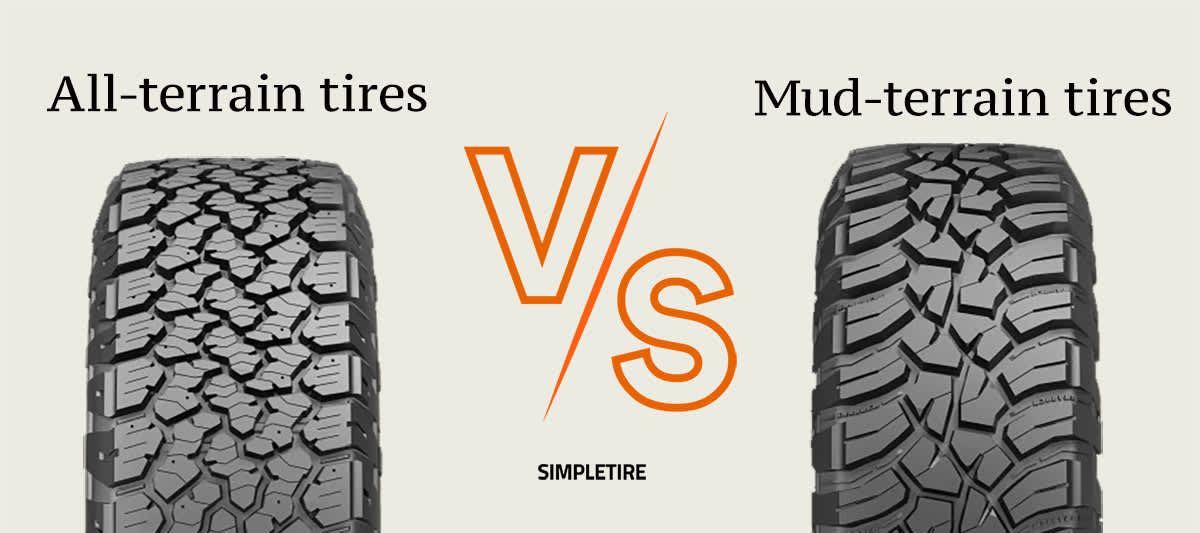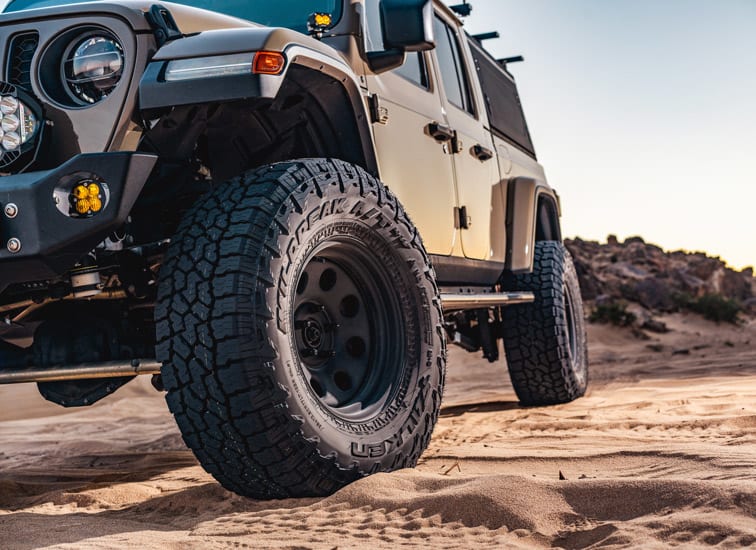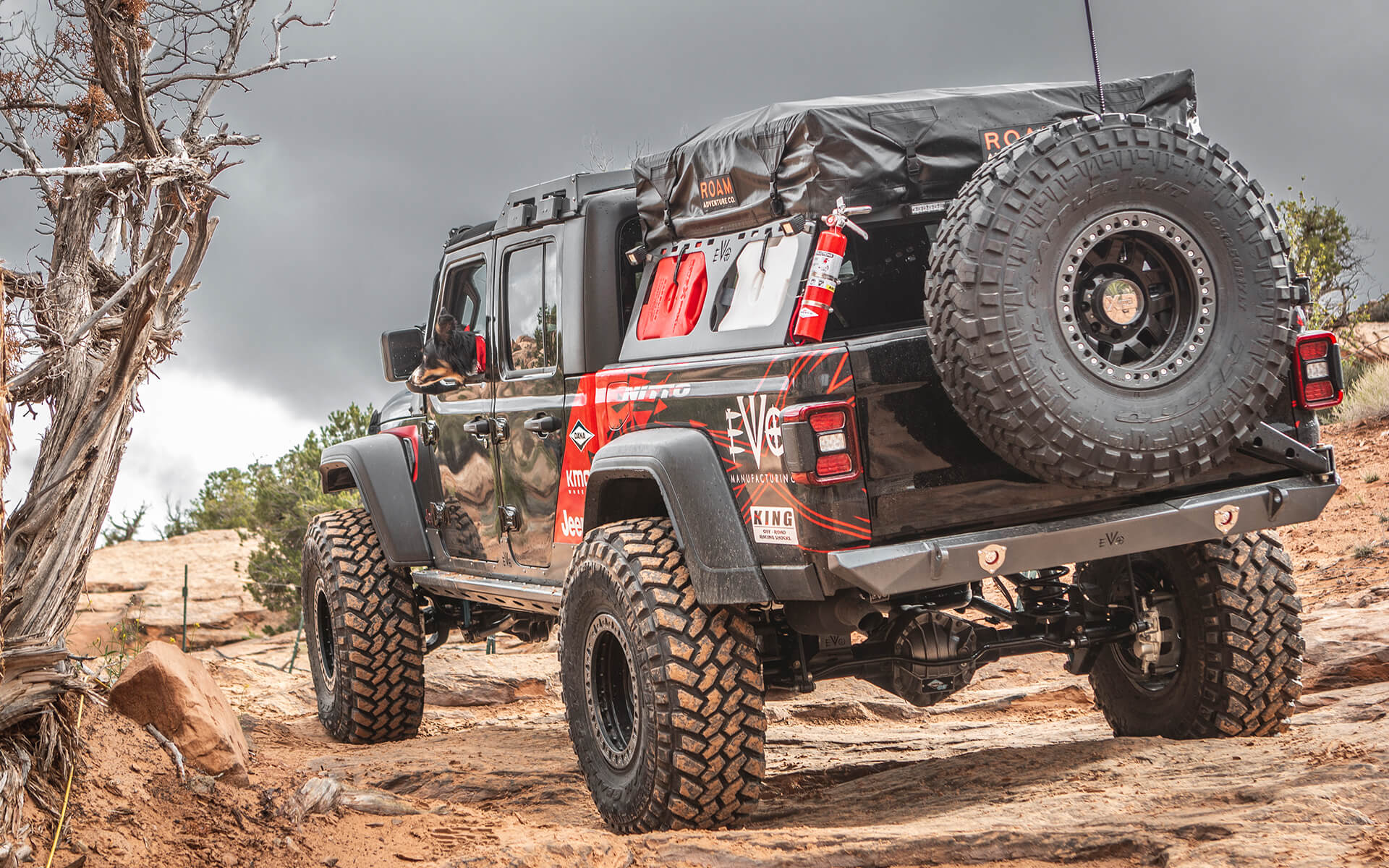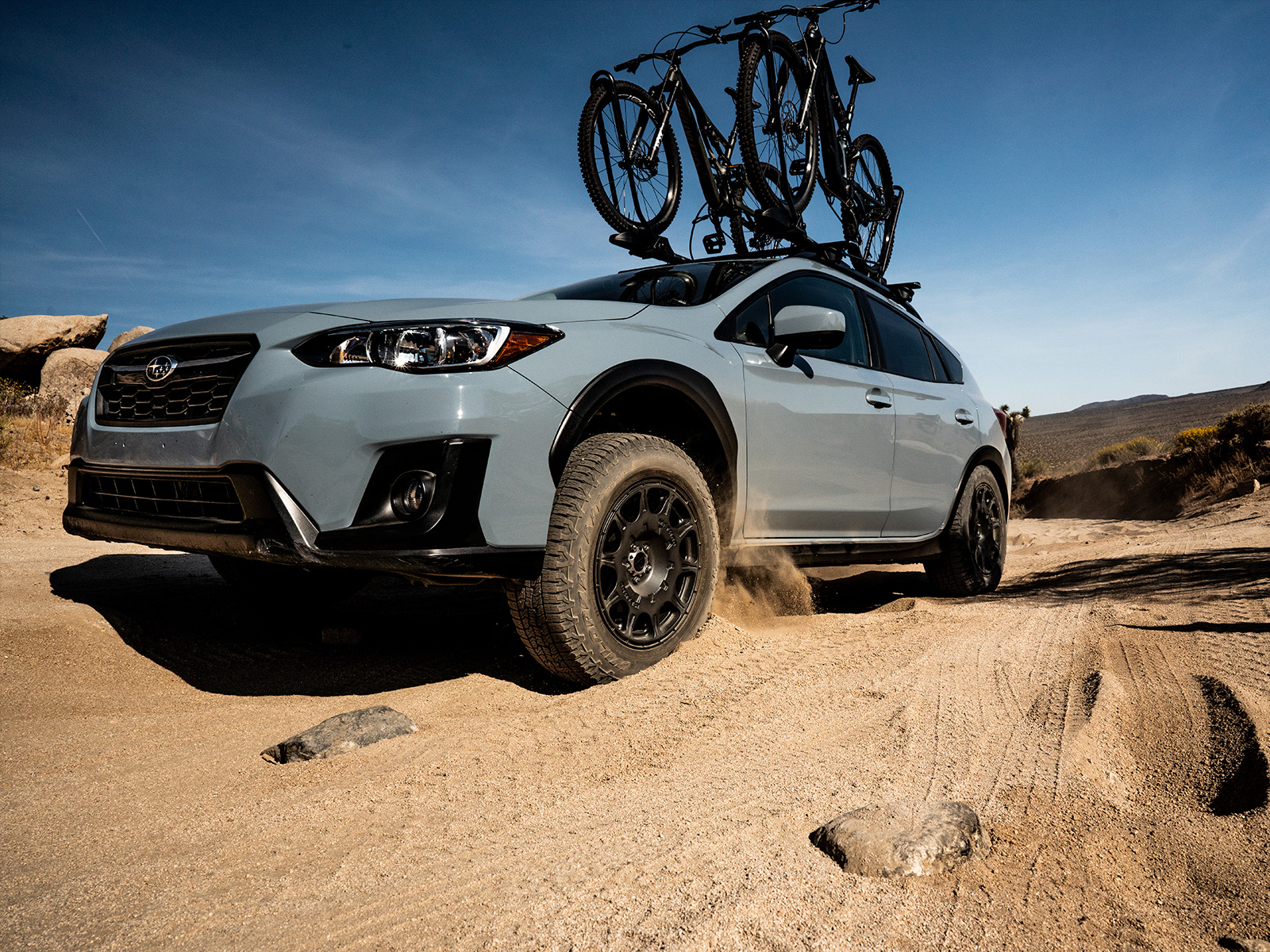Compare
Free shipping
Best price guarantee
Special pricing
Financing with Resolve
Easy returns

When it comes to choosing the right tires for your vehicle, the decision can be daunting, especially if you enjoy a mix of on-road and off-road adventures. Two popular tire categories that often come up in this discussion are all-terrain and mud-terrain tires.
Each type of tire is designed with specific performance characteristics in mind, catering to different driving conditions and vehicle requirements. Understanding the key differences between all-terrain and mud-terrain tires is crucial for making an informed decision that aligns with your unique needs and preferences.
In this article, we'll dive deep into the world of all-terrain and mud-terrain tires, exploring their distinct features, advantages, and limitations. By the end, you'll have a clearer picture of which tire type is the best fit for your vehicle and driving style.
What's the Difference Between All-Terrain and Mud-Terrain Tires?
All-terrain tires are designed to provide a balanced performance across various driving conditions, both on and off the road. They feature a more compact tread pattern compared to mud-terrain tires, with tighter spacing between the tread blocks. This design choice results in a quieter and more comfortable ride on paved surfaces while still offering adequate traction on mild off-road trails.
One of the key advantages of all-terrain tires is their longer tread life. These tires typically utilize harder rubber compounds, which contribute to their durability and resistance to wear. Additionally, the more compact tread pattern of all-terrain tires leads to better fuel efficiency compared to their mud-terrain counterparts.
On the other hand, mud-terrain tires are specifically engineered to tackle the most challenging off-road conditions, such as deep mud, loose sand, and rocky terrain. They feature large, aggressive tread blocks with wide voids between them. This design allows the tire to effectively evacuate mud and debris, maintaining traction in even the most demanding situations.
To further enhance their off-road capabilities, mud-terrain tires often incorporate softer rubber compounds. These compounds provide increased grip and conformity to uneven surfaces, ensuring maximum traction when navigating rough terrain. Additionally, many mud-terrain tires feature reinforced sidewalls to protect against punctures and cuts from sharp rocks and other obstacles encountered in extreme off-road environments.
While mud-terrain tires excel in off-road performance, they do come with some trade-offs. The aggressive tread pattern and softer rubber compounds can result in increased road noise and a less comfortable ride on paved surfaces compared to all-terrain tires. Additionally, the softer compounds and larger tread blocks of mud-terrain tires tend to wear more quickly, resulting in a shorter tread life.
Ultimately, the choice between all-terrain and mud-terrain tires depends on your specific driving needs and preferences. If you spend most of your time on paved roads with occasional mild off-road excursions, all-terrain tires offer a well-rounded solution. However, if you frequently tackle challenging off-road conditions and prioritize maximum traction and durability, mud-terrain tires are the way to go.
Pros and Cons of All-Terrain vs. Mud-Terrain Tires
All-Terrain Tire Advantages

All-terrain tires are crafted to deliver balanced performance across diverse driving scenarios. Their design optimizes traction on various surfaces, from paved roads to moderately challenging trails, ensuring a stable and composed ride. The unique tread pattern minimizes road noise, enhancing the overall driving experience on highways.
-
Adaptability: These tires provide consistent performance on a range of surfaces, making them suitable for both urban and rural settings. The tread design supports effective handling and reduced noise, contributing to a smoother ride on asphalt.
-
Extended tread life: Utilizing durable rubber formulations, all-terrain tires are built to withstand wear and tear over time. This resilience results in fewer replacements and long-term savings for those who navigate a mix of city streets and backroads.
-
Economic fuel use: With their efficient design, all-terrain tires contribute to improved fuel consumption. The streamlined tread helps decrease rolling resistance, allowing drivers to enjoy more miles per gallon.
Mud-Terrain Tire Advantages

Mud-terrain tires are engineered for the most demanding off-road conditions, offering unmatched traction and durability. Their aggressive tread and reinforced build make them ideal for navigating rugged landscapes and overcoming obstacles.
-
Superior off-road grip: Large, spaced tread lugs are tailored for challenging terrains, enhancing grip on loose or muddy surfaces. This design ensures your vehicle maintains traction in the most demanding scenarios.
-
Robust build: Constructed with tough materials and reinforced sidewalls, these tires resist damage from sharp objects and challenging environments. Their resilience makes them a dependable choice for off-road enthusiasts.
-
Aggressive aesthetic: Mud-terrain tires not only deliver performance but also elevate your vehicle's appearance with their rugged styling. The bold tread pattern signals a readiness to tackle any off-road adventure.
Each tire type offers unique benefits tailored to specific driving needs, providing options that cater to both performance and aesthetic preferences.
Factors to Consider When Choosing Between All-Terrain and Mud-Terrain Tires
1. Driving Environment and Terrain Exposure Assess the environments where you typically drive—whether it's city streets, highways, or rugged trails. For drivers who mainly traverse urban landscapes with occasional off-road ventures, all-terrain tires offer the flexibility needed to handle diverse conditions. However, if your adventures frequently lead you through challenging terrain, mud-terrain tires provide the specialized traction necessary for conquering such paths.
2. Vehicle Specifications and Load Requirements Consider the specifications of your vehicle, including its weight and any additional loads you may carry. Heavier vehicles or those used for towing demand robust tires that can handle increased stress without sacrificing performance or safety. Mud-terrain tires, known for their reinforced construction, are well-suited for these scenarios, offering the durability required for heavy-duty use.
3. Noise Levels and Ride Experience Evaluate your preference for ride quality and noise levels. All-terrain tires generally provide a smoother, quieter ride on paved roads, making them appealing to drivers who prioritize comfort. Their design often contributes to better mileage, making them an economical choice for those mindful of fuel consumption.
4. Off-Road Frequency and Challenges Reflect on how often and intensely you engage in off-road activities. Mud-terrain tires excel in severe conditions, such as deep mud and rocky trails, making them ideal for avid off-road enthusiasts. For those who only occasionally explore off-road paths, all-terrain tires offer a balanced approach, delivering reliable performance in a variety of settings.
5. Financial Planning Financial considerations are crucial when selecting tires. All-terrain tires typically offer a more budget-friendly option, providing a cost-effective solution for drivers seeking versatility without the expense of specialized mud-terrain tires. Consider the potential savings from longer tread life and improved fuel efficiency when planning your tire investment.
Which Tire is Best for Your Needs?

Consider All-Terrain Tires If:
All-terrain tires are an optimal choice for drivers who predominantly stick to paved surfaces with occasional off-road detours. These tires are crafted to deliver a seamless blend of road handling and light off-road capability, ensuring reliability in a variety of driving situations. With their intricate tread designs, all-terrain tires provide a comfortable driving experience while promoting efficient fuel use over extended distances.
These tires excel in regions where weather conditions fluctuate, handling diverse climates with ease. If you reside in areas prone to intermittent snow or rain, all-terrain tires offer dependable traction and stability. This makes them particularly suited for those who encounter varied road surfaces and weather patterns throughout the year.
Drivers seeking a tire that accommodates both daily commutes and occasional off-road adventures will find all-terrain tires meet their needs. They provide the adaptability required for an array of driving conditions, ensuring a smooth transition from city streets to rural trails.
Choose Mud-Terrain Tires If:
Mud-terrain tires cater to off-road enthusiasts who regularly navigate demanding environments. For those who frequently encounter challenging conditions such as deep mud or rocky trails, these tires provide the robust grip and durability necessary to conquer such terrains. Their bold tread patterns and durable construction equip vehicles to handle the harshest off-road scenarios.
Although these tires shine in off-road settings, they come with certain compromises. The increased traction and rugged build can lead to more noticeable road noise and a stiffer ride on highways. However, for those prioritizing off-road capabilities, these trade-offs are often seen as a fair exchange.
The distinctive design of mud-terrain tires also enhances the vehicle's visual appeal, attracting drivers who appreciate a daring and adventurous aesthetic. For those who embrace off-roading as a core aspect of their lifestyle, mud-terrain tires offer the essential features to tackle the most extreme trails, ensuring no terrain poses a barrier to exploration.
Making the Right Choice for Your Vehicle and Driving Style

When evaluating which tires best suit your vehicle, begin by reflecting on your typical driving conditions. Determine whether your paths primarily involve city streets, country roads, or rugged backcountry trails. This insight is pivotal in choosing the tire type that will enhance your driving experience and vehicle performance.
Identifying the tire characteristics that matter most to you is essential. Some drivers seek enhanced grip and toughness for off-road excursions, while others may value smoothness and economical fuel use for extended highway journeys. Understanding which aspects are most crucial to you will help in selecting a tire that aligns with your lifestyle and vehicle demands. Exploring feedback from fellow drivers who share similar vehicles and driving patterns can provide valuable insights. Engaging with tire experts can also offer clarity, guiding you through the intricate details of tire options and suitability for your specific vehicle.
Finally, factoring in the long-term financial implications of your tire choice, including potential replacement costs and fuel efficiency, is crucial. While the initial investment is important, considering how tires impact overall expenses, in the long run, ensures that your selection provides both immediate satisfaction and sustainable value.
Choosing the right tires for your vehicle is a decision that requires careful consideration of your driving habits, environment, and personal preferences. We're here to help you navigate the process and find the perfect set of tires that will keep you safe, comfortable, and ready for any adventure. Shop for tires online and let us help you find the best deals on the tires you need.
Ready to find the perfect tires?
Search By